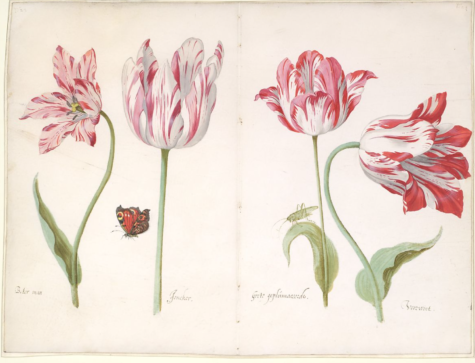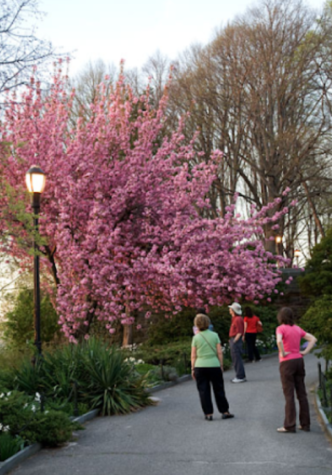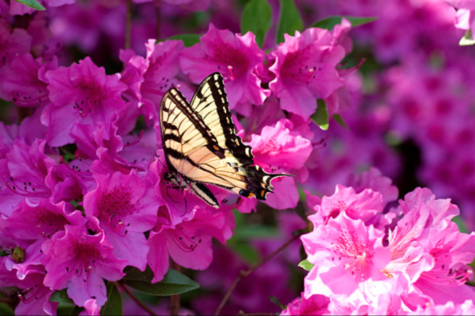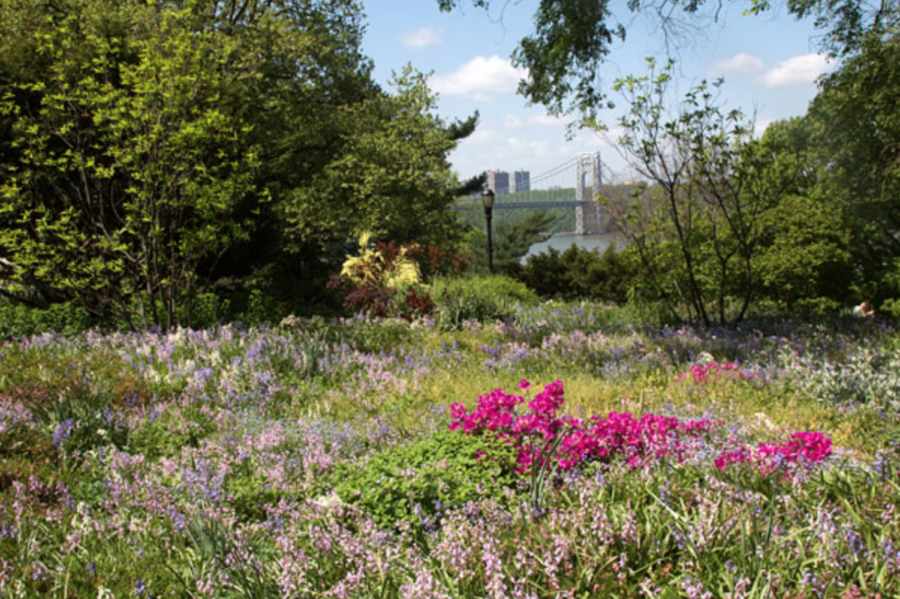Fantastic Spring Flowers and Where to Find Them
From tulips to flowering cherry trees, New York City parks are springing alive.
Used by permission of Gabe Kirchheimer
Here are Spring flowers in bloom in Fort Tryon Park’s Heather Garden in Upper Manhattan.
Those who come to live in New York City certainly do not come here for the flora. The very lack of greenery is why some who have the means to do so choose to leave — or seek respite in the Hudson Valley, Long Island, or the Catskills, from the harsh and overwhelming aura of concrete. As we often remain rooted in our urban habits — and habitats — it’s quite easy to lose touch with the natural world. For the most weathered New Yorkers, perhaps, there was never a relationship to lose. But, all across the city, as people begin to gather in parks and stow their clunky winter boots away, another population is awakening: the flowers.
Following a soft and dainty prelude from the crocuses and snowdrops, daffodils take the stage around late March, soon joined by the tulips. These bright, colorful, one-foot tall blooms are a reminder of New York’s Dutch origins. Arriving around the same time as Henry Hudson, they quickly became part of the city’s natural landscape.

Originally imported from the Ottoman Empire, tulips and daffodils were extremely popular among Dutch citizens in the 17th century. Demand caused prices to skyrocket. Scottish author Charles MacKay coined the term “Tulipomania” in an 1841 book, to describe the phenomenon. As MacKay described it, everyone, from nobility to farmers and maids, was drawn to these colorful flowers, “like flies around a honey-pot.” When they came to New Amsterdam, Dutch settlers brought these bulbs with them, along with a variety of roses, gilliflowers, white lilies, anemones, violets, and marigolds, and cultivated gardens, orchards, and farms.
Beginning in 2002 as a citywide “living memorial” to the victims of the September 11th attacks, a nonprofit organization called The Daffodil Project has been responsible for distributing and planting over eight million flower bulbs in New York City. This project began when the city was gifted one million daffodil bulbs by Dutch bulb supplier Hans van Waardenburg and the City of Rotterdam in the Fall of 2001. In 2021, The Daffodil Project expanded their work to honor those lost to COVID-19.
“The Daffodil Project represents communal healing and recovery, which has been needed now more than ever as our city emerges from another devastating crisis,” said Adam Ganser, Executive Director of New Yorkers for Parks. “This annual effort is an important memorial to those we’ve lost, and yet also reminds us of how we can grow and heal together. We’re proud of The Daffodil Project’s legacy and ongoing commitment to making our green open spaces more beautiful, accessible, and meaningful to New Yorkers.”

Around mid-April, along the Hudson River, in Flushing Meadows-Corona Park, and throughout the city, another flower is blooming: the Cherry Blossom. In 1912, Japan sent over 3,000 cherry trees to honor the friendship between the two nations. The trees that came to New York City were planted in Sakura Park, located next to Riverside Church in Manhattan’s Morningside Heights. In years since, many more trees have been donated by Japan. Today, there are more than 40,000 ornamental cherry trees in New York City, with the most common varieties being the Okame, Yoshino, and Kwanzan. For a particularly spectacular display, take the B/D, 2/3, or 4/5 trains to the Brooklyn Botanic Garden for a chance to glimpse these whimsical pink blooms.
Despite the great variety we see, few of the flowers grown in the city today are native to the area. “You have to consider that all the soil in New York City has been disturbed at one time or another, except in small pockets,” Dianne Crary, a New York-based horticulturist, explained to me. In Central Park, Manhattan’s verdant crown jewel, approximately 70% of species once present in the 19th and 20th centuries have been extirpated (meaning they no longer exist in the area), reflecting a greater phenomenon of loss of New York’s native flora. Today, many organizations, including the New York City Department of Parks and Recreation, work to preserve and re-plant native species. These species include purple coneflower, false sunflower, mountain laurel, and many asters and geraniums, according to Crary.
Sean Kiely, the park manager for the Battery Park Conservatory, discussed the importance of promoting native biodiversity. “Native plants are what the pollinators need and want to survive. For years we have been planting exotics, plants that are not from here, and the bees and other insects aren’t interested in them,” he explained. “Our gardeners have been introducing native perennials to all our gardens for the past several years already and will continue to do so.”

For those who desire a more curated experience, parks, conservatories, and gardens across the city offer New Yorkers an opportunity to immerse themselves in nature. Amongst the azaleas, peonies, and magnolia trees, we find a sense of wonder and awe. As the sun releases the sweet aromas of lilacs and gardenias, the dainty chimes of snowbells, lily-of-the-valley, and Spanish bluebells call to the butterflies and bumblebees. Step into a garden for an afternoon and admire the symphony.
To see which flowers are in bloom in your borough each month, check out this helpful guide: https://www.nycgovparks.org/greening/bloom-guide
Sean Kiely, the park manager for the Battery Park Conservatory, discussed the importance of promoting native biodiversity. “Native plants are what the pollinators need and want to survive. For years we have been planting exotics, plants that are not from here, and the bees and other insects aren’t interested in them,” he explained.
Nora Sissenich is an Editor-In-Chief for 'The Science Survey,' a role that she values deeply because it allows her to offer guidance and insight through...











